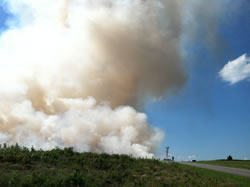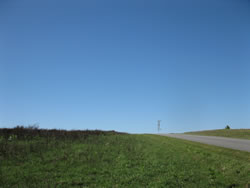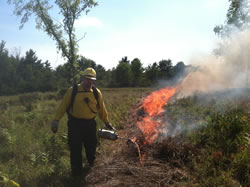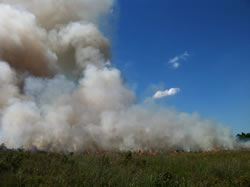National Cohesive Wildland Fire Management Strategy Success Story
Expanding Burn Windows to Include Growing Season
Saratoga National Historical Park, New York
Cohesive Strategy – Maintain and Restore Landscapes and Response to Wildfire
2012

Chatfield Farm during firing. NPS / David Crary.

One month post-burn, native warm season grasses have returned and standing woody vegetation has been killed. NPS / Jacquie Tinker.

Devin Randall from Saratoga NHP used a drip torches for firing operations. NPS / David Crary.

Prescribed burns at Saratoga National Park are used to maintain the historic conditions of the Revolutionary War battlefield. NPS / David Crary.
In August 2012, managers at Saratoga National Historical Park implemented a growing season prescribed fire project to maintain and restore its Revolutionary War battlefield. In 1777, the Saratoga Battlefield was the site of a crucial victory for American forces known as The Turning Point of the Revolutionary War. The park has historically conducted prescribed burns in the spring. This shift from spring to summer burning is an experimental approach to see if the application of fire at a different time of year will decrease unwanted invasive and woody stemmed plants and increase desired native species in fields. Short and long-term monitoring plans are in place to evaluate the results. The Area Fire Ecologist will analyze monitoring data then submit a report to the park's Resource Program Manager that details fire effects and suggest alternative management actions if vegetation objectives were not met.
For over twenty years, prescribed fires have been a valuable and safe tool in managing Saratoga Battlefield's 3200 acres. Planned burns allow the park to maintain its treasured landscape for its historic importance, scenery and views, value as open space, reduce the spread of exotic plant species, encourage regeneration of natural grasses and eliminate the need for personnel to work on hazardous slopes with mechanical equipment. Additionally, fuel reduction around developed areas provides for firefighter safety and improves community and structure protection in the event of a natural wildfire.
Wildland firefighters from Saratoga National Historical Park, Acadia National Park, Cape Cod National Seashore, and Delaware Water Gap National Recreation Area came together to manage and carry out the prescribed burn. In addition to national park staff, firefighters from local organizations participated in the burn. For over a decade Saratoga NHP staff has maintained and furthered partnerships with local and state entities to provide cooperative assistance during burn operations. Partners include the New York State Forest Rangers, Albany Pine Bush Preserve, and Quaker Springs Fire Department.
These operations allowed fire personnel to gain valuable firefighting experience, sharpen their existing skills, and maintain readiness skills. They also completed many task book training opportunities that increased their qualifications in advance of wildfire incidents. Joint activities between the National Park Service, local and state agencies increase efficiency and improve wildfire response, all practices that align with the National Cohesive Wildland Fire Management Strategy for responding to wildfires. Further, agencies learned about each other's fire management goals and fire use practices, like the use of prescribed burns to maintain and restore natural and cultural landscapes in national parks. In addition, projects such as these meet the National Park Service Call to Action through inclusion of local firefighters in projects that expand and protect park resources that are special to their community's history and economic and environmental sustainability.
Contact: Greg Wozniak, Chief Ranger, Saratoga National Historical Park, Greg_Wozniak@nps.gov, (518) 670-2960.
Keywords: Maintain and Restore Landscapes, Responding to Wildfires, treasured landscapes, Call to Action